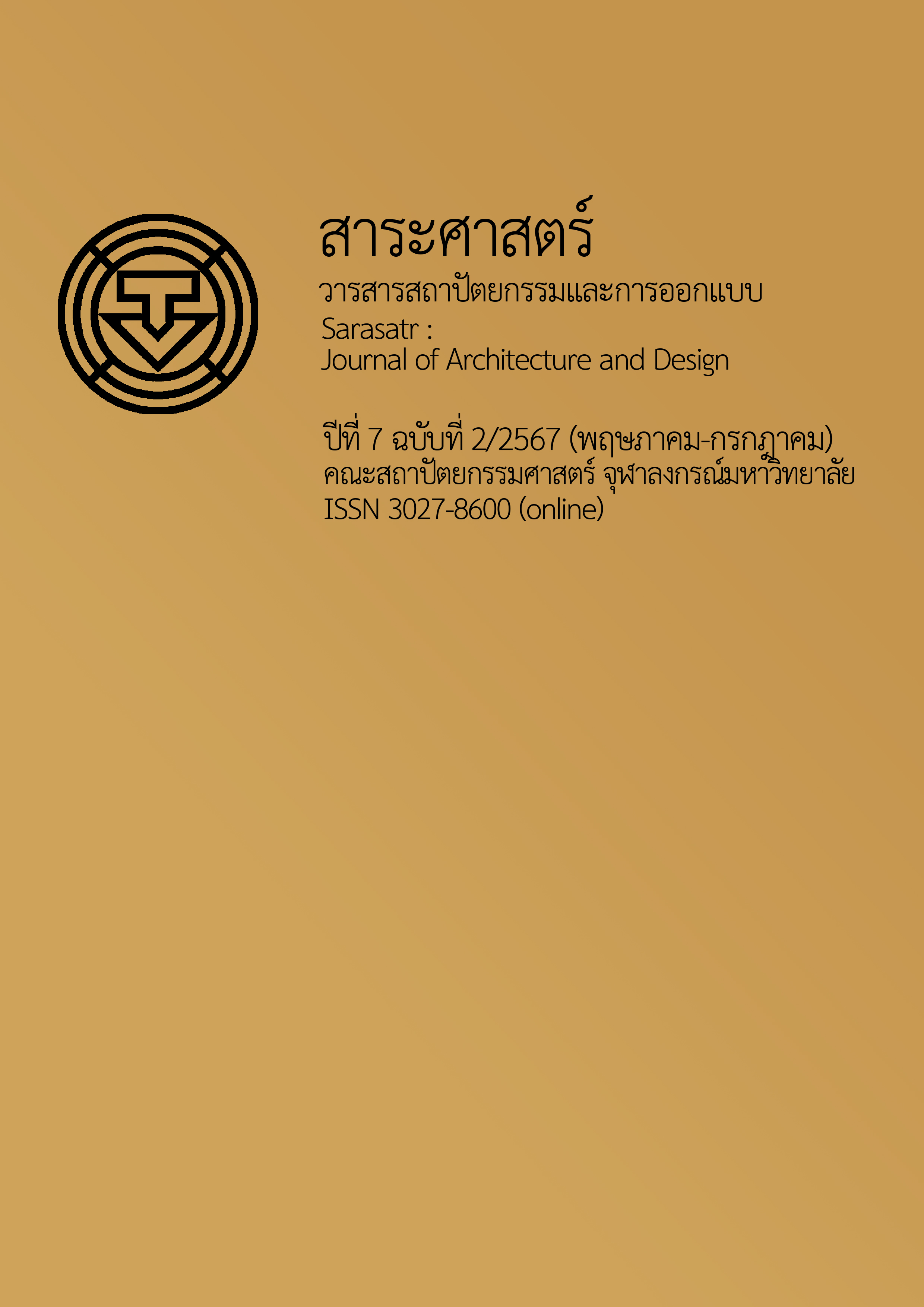เมืองที่เชื่อมต่อกันด้วยถนนและทางเท้าที่เป็นมิตรกับผู้สูงอายุ กรณีศึกษา ย่านบางรัก กรุงเทพมหานคร
Main Article Content
บทคัดย่อ
งานวิจัยนี้มีวัตถุประสงค์เพื่อศึกษาและวิเคราะห์พื้นที่ ประเมินศักยภาพของถนนและทางเท้าในการเชื่อมต่อกับระบบขนส่งสาธารณะที่เหมาะสมกับการใช้งานผู้สูงอายุในย่านบางรัก และเสนอแนะแนวทางพัฒนาถนนและทางเท้าที่ส่งเสริมการเดินทางเมืองอย่างเท่าเทียมของผู้สูงอายุในย่านบางรัก โดยใช้วิธีการวิจัยแบบผสมผสาน จากการทบทวนวรรณกรรมที่เกี่ยวข้องกับพื้นที่ ข้อมูลสภาพการณ์จากบริบทสภาพแวดล้อมเชิงพื้นที่ในปัจจุบัน ด้วยวิธีการสำรวจจากเครื่องมือแผนที่จดบันทึกและแบบสำรวจ วิเคราะห์ข้อมูลจากปรากฏการณ์ของสถานที่ ถนน ทางเท้า ระบบขนส่งสาธารณะ และพฤติกรรมผู้สูงอายุในช่วงเวลาเช้า สาย เที่ยง บ่าย และเย็นถึงค่ำในช่วงเดือนตุลาคม พ.ศ. 2566 ด้วยวิธีการสังเกต และบันทึกพฤติกรรมเชิงพื้นที่ สังเคราะห์ข้อมูลเพื่อประเมินศักยภาพจากเกณฑ์ที่สรุปได้จากแนวคิดเมืองที่เชื่อมต่อกันด้วยถนนและทางเท้าที่เป็นมิตรกับผู้สูงอายุ มาเปรียบเทียบเพื่อเสนอแนะแนวทางพัฒนาถนนและทางเท้าในรูปแบบต่าง ๆ
ผลการศึกษาพบว่า ย่านบางรัก เป็นหนึ่งในพื้นที่ที่มีความสามารถในการเข้าถึงด้วยการเดินเท้าเชื่อมต่อกับระบบขนส่งสาธารณะได้หลากหลายรูปแบบ ถือเป็นพื้นที่ถ่ายเทผู้คนในพื้นที่ จากการประเมินศักยภาพด้วยเกณฑ์หลัก 7 ข้อ ข้อย่อยรวม 25 ข้อ พบว่าย่านบางรักเป็นย่านที่มีเครือข่ายทางเท้าเชื่อมต่อกับระบบขนส่งสาธารณะและมีความกระชับอยูในระดับปานกลาง ควรปรับปรุงให้เป็นเครือข่ายทางเท้าที่คล่องตัว เชื่อมต่อสภาพแวดล้อม และให้มีความปลอดภัยเพิ่มมากขึ้น โดยสิ่งที่ต้องปรับปรุงยังคงเป็นปัญหาในพื้นที่ที่ส่งผลต่อพฤติกรรมการใช้งานทางเท้าของผู้สูงอายุที่ต้องคอยระมัดระวังเป็นพิเศษในการข้ามหรือเชื่อมต่อในพื้นที่ ควรเพิ่มเติมให้เป็นเครือข่ายทางเท้าที่เชื่อมต่อกับถนนอย่างต่อเนื่อง และเพิ่มประสิทธิภาพทางเท้า เพื่อให้ถนนและทางเท้าย่านบางรักเป็นมิตรกับผู้สูงอายุให้มากกว่าที่เป็นอยู่ ซึ่งเป็นสิ่งที่ต้องให้ความสำคัญเป็นลำดับแรกในการพัฒนาพื้นที่ในด้านต่าง ๆ ถือเป็นสิทธิขั้นพื้นฐานของผู้สูงอายุ รวมถึงการให้ความสำคัญกับทางเท้าสำหรับคนทุกคนให้มีสิทธิในการเข้าถึงและใช้งานเป็นหลัก จะส่งผลให้เมืองมีการพัฒนาในรูปแบบที่บริบทต่าง ๆ เกื้อกูลกันไป ทั้งมิติของผู้คน เศรษฐกิจในพื้นที่ เกิดสภาพแวดล้อมและสภาพสังคมที่ดี และเกิดการพัฒนาที่ยั่งยืนต่อไป
Article Details
เอกสารอ้างอิง
กรมกิจการผู้สูงอายุ. (2565). แผนปฏิบัติการด้านผู้สูงอายุ ระยะที่ 3 (พ.ศ. 2566-2580). กรมกิจการผู้สูงอายุ กระทรวงการพัฒนาสังคมและความมั่นคงของมนุษย์.
คณะกรรมการพัฒนาแผนการส่งเสริมกิจกรรมทางกาย. (2561). แผนการส่งเสริมกิจกรรมทางกาย (พ.ศ. 2561 - 2573). บริษัท เอ็นซี คอนเซ็ปต์ จำกัด.
นิรมล เสรีสกุล และอดิศักดิ์ กันทะเมืองลี้. (2565). ดัชนีเมืองเดินได้ : การศึกษาเพื่อจัดทำตัวชี้วัดและประเมินศักยภาพคุณลักษณะของเมืองที่ส่งเสริมการสัญจรด้วยการเดินเท้าของมหานครกรุงเทพ. วารสารหน้าจั่ว : ว่าด้วยประวัติศาสตร์สถาปัตยกรรมและสถาปัตยกรรมไทย, 19(2), 246-287.
วรางคณา ทองด้วง และพฤฒิพงศ์ อภิวัฒนกุล. (2564). การเปรียบเทียบปัจจัยด้านการขนส่งสาธารณะระหว่างกลุ่มผู้สูงอายุและกลุ่มคนทำงาน กรณีศึกษาเส้นทางการเดินทางของผู้ใช้บริการรถไฟฟ้าบีทีเอส. วารสารรัฐประศาสนศาสตร์ มหาวิทยาลัยราชภัฎสวนสุนันทา, 4(2), 83-98.
สำนักงานนโยบายและแผนการขนส่งและจราจร [สนข.]. (2566). รายงานประจำปี สนข. ประจำปี 2565. สนข. กระทรวงคมนาคม.
สรวิศ รุ่งโรจนารักษ์. (2562). สัณฐานเมืองเพื่อการพัฒนาย่านสร้างสรรค์บางรัก กรุงเทพมหานคร [วิทยานิพนธ์ปริญญามหาบัณฑิต ไม่ได้ตีพิมพ์]. มหาวิทยาลัยศิลปากร.
สำนักการวางผังและพัฒนาเมือง กรุงเทพมหานคร. (2566). ระบบตรวจสอบผังเมืองรวมและข้อบัญญัติกรุงเทพมหานคร. สำนักการวางผังและพัฒนาเมืองกรุงเทพมหานคร. https://cityplangis.bangkok.go.th/BMA_CPUDD/CMPWeb fbclid=IwAR1M7IqseqmqQ03dEywdfLkvzOlN0K6Br2ilYvIN1xrPsf21_hSEhmQqodw
สำนักงานเขตบางรัก. (2561). ข้อมูลทั่วไปของเขต. สำนักงานเขตบางรัก. https://webportal.bangkok.go.th/bangrak/page/sub/8026/ข้อมูลทั่วไป
สำนักงานส่งเสริมและพิทักษ์ผู้สูงอายุ. (2553). พระราชบัญญัติผู้สูงอายุ พ.ศ. 2546 ฉบับปรับปรุง พ.ศ. 2553. โรงพิมพ์เทพเพ็ญวานิสย์.
สำนักงานสภาพัฒนาการเศรษฐกิจและสังคมแห่งชาติ. (2562). รายงานการคาดประมาณประชากรของประเทศไทย พ.ศ. 2553-2583 (ฉบับปรับปรุง). อมรินทร์.
สำนักงานสภาพัฒนาการเศรษฐกิจและสังคมแห่งชาติ. (2565a). แผนพัฒนาเศรษฐกิจและสังคมแห่งชาติ ฉบับที่สิบสาม พ.ศ. 2566-2570. สำนัก.
สำนักงานสภาพัฒนาการเศรษฐกิจและสังคมแห่งชาติ. (2565b). แผนพัฒนาประชากรเพื่อการพัฒนาประเทศระยะยาว (พ.ศ. 2565-2580). สำนัก.
สำนักบริหารการทะเบียน. (2566). สถิติประชากรทางการทะเบียนราษฎร (รายเดือน) ; พื้นที่จังหวัดกรุงเทพมหานคร ข้อมูลเดือนพฤศจิกายน 2566. สำนักบริหารการทะเบียน กรมการปกครอง. https://stat.bora.dopa.go.th/stat/statnew/statMONTH/statmonth/#/mainpage
สำนักยุทธศาสตร์และประเมินผล กรุงเทพมหานคร. (2565a). แผนพัฒนากรุงเทพมหานครระยะ 20 ปี (พ.ศ. 2561-2580) ฉบับปรับปรุง. สำนัก.
สำนักยุทธศาสตร์และประเมินผล กรุงเทพมหานคร. (2565b). แผนพัฒนากรุงเทพมหานครระยะ 20 ปี ระยะที่ 3 (พ.ศ. 2566-2570). สำนัก.
โสมสกาว เพชรานนท์, เอกภัทร ลักษณะคำ, และวรานันต์ ตันติเวทย์. (2562). พฤติกรรมของผู้สูงอายุในการใช้พื้นที่ทางเท้าและมูลค่าทางเศรษฐศาสตร์ของพื้นที่ทางเท้า. วารสารการบริหารท้องถิ่น, 12(3), 398-418.
ASA. (2561). Bangkok walking guide. สมาคมสถาปนิกสยาม ในพระบรมราชูปถัมภ์.
ESCAP. (2023). Crisis resilient urban futures: The future of Asian & Pacific cities 2023. United Nations.
Global Designing Cities Initiative, & National Association of City Transportation Officials. (2016). Global street design guide. Island Press.
HLAG. (2016). Mobilizing sustainable transport for development: Analysis and policy recommendations from the United Nations Secretary-General’s high-level advisory group on sustainable transport. United Nations.
SuM4All. (2023). Global mobility report 2022: Tracking sector performance. Sustainable Mobility for All, World Bank.
Tennøy, A., Knapskog, M., & Wolday, F. (2022). Walking distances to public transport in smaller and larger Norwegian cities. Transportation Research Part D: Transport and Environment, 103, 103169.
UNDP Thailand. (2022). SDG investor map Thailand 2022. United Nations Development Programme, UNDP Thailand.
UN-Habitat. (2023). My neighborhood. United Nations Human Settlements Programme (UN-Habitat).
United Nations. (2023a). Goals 11 make cities and human settlements inclusive, safe, resilient, and sustainable. Goal 11 infographic. https://unstats.un.org/sdgs/report/2023/
United Nations. (2023b). The sustainable development goals report 2023: Special edition, towards a rescue plan for people and planet. United Nations.
VNRs. (2019). Thailand's voluntary national review on the implementation of the 2030 agenda for sustainable development 2018. Department of International Organizations, Ministry of Foreign Affairs.
World Health Organization [WHO]. (2007). Global age-friendly cities: A guide. WHO.
World Health Organization [WHO]. (2013). Make walking safe: A brief overview of pedestrian safety around the world. WHO.


